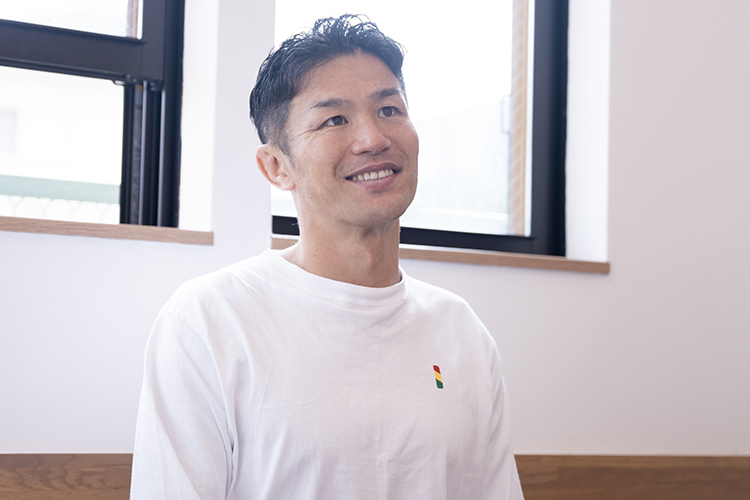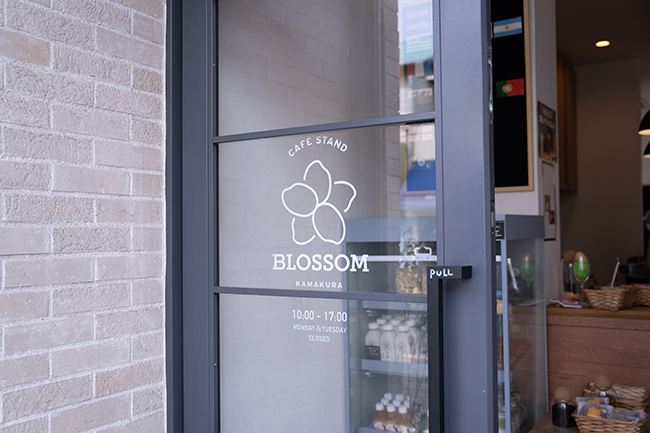Creative Amazake Menu at CAFE STAND BLOSSOM
Nov 09,2023
Creative Amazake Menu at CAFE STAND BLOSSOM
Nov 09,2023


The Hase neighborhood of Kamakura is always bustling with visitors eager to see the ancient city’s famed Great Buddha. It’s also the site of Cafe Stand Blossom, which showcases the sweet fermented beverage amazake. Cafe Stand Blossom, which opened in February 2023, is the brainchild of Hirose Toshiaki, former captain of the Japanese national rugby team. Toshiaki, who was appointed a Marukome Miso Ambassador in 2021, has worked on various initiatives in the field of fermentation. We visited his new cafe to talk to him and learn more.
Cafe Stand Blossom is a chic-looking building not far from Hase Station on the Enoshima Electric Railway. It’s instantly identifiable by the flower design on the outside. The nickname of the Japanese national rugby team, by the way, is the Brave Blossoms. Cafe Stand Blossom is thus the perfect moniker for an establishment run by a former player. But initially, it wasn’t even in the running.
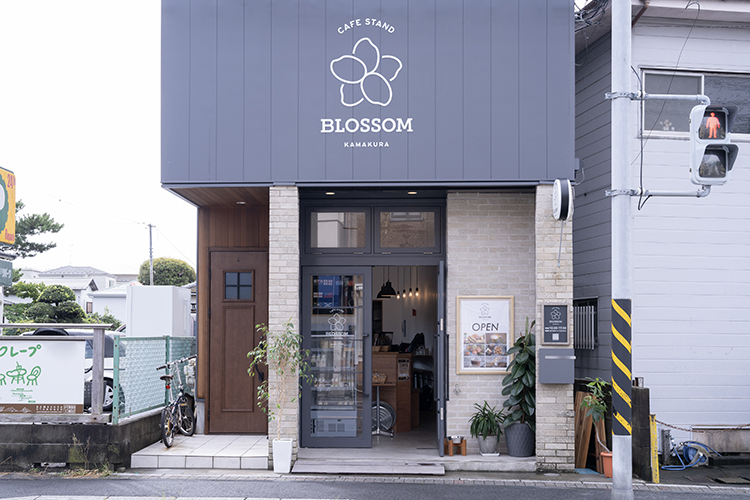
The cafe is a three-minute walk from Hase Station with the sea behind you. It’s on your right-hand side at the Hase Kannon Mae intersection.
“‘Blossom’ didn’t even occur to me at first. When a friend suggested it, I thought no way. It was too closely associated with rugby. But ‘blossom’ also means to open, of a flower, so I thought it might be a nice fit with the name of my company, HiRAKU, which means to open as well. And so I ended up adopting it as the name of my cafe. The flower petals in the logo are stylized rice grains!”
Cafe Stand Blossom with its rice-petal logo is beloved of sightseers and locals alike. It offers a wide assortment of amazake-themed items and vegan selections.
“In sports, your body is your biggest asset, and I was keenly aware of the importance of diet, so I’d always been interested in food. I envisioned myself pursuing a career in food one day, though I didn’t have an exact idea whether that would be running a restaurant, a shop, or a cafe. After retiring from professional sports, I started studying fermentation. I then decided to open a fermentation-themed cafe to spread the word about its wonders. I chose Kamakura as the location in part because I’d moved to nearby Fujisawa six years before. But the biggest reason was that I liked this area. It has a lot of history, and I thought it was a great location for showcasing fermentation, which has been part of Japanese life for centuries.”
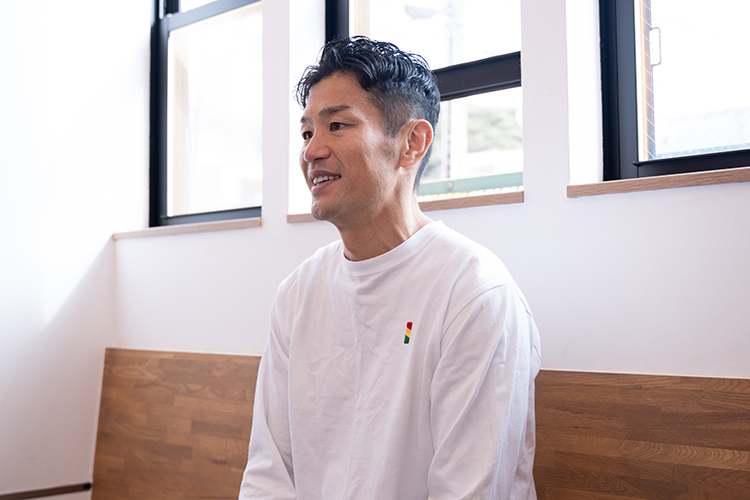
The Cafe Stand Blossom menu also features vegan items with a fermented twist. That’s in part the influence of the various culinary cultures that Toshiaki has encountered visiting different parts of the globe.
“I traveled all over the world on tour back in my professional days, and I often got to experience different food cultures. Vegan items were available on the menu as a matter of course, especially in Europe and North America. Here in Japan, vegan food may have become fairly common in Tokyo, but I don’t feel it’s yet caught on in outlying regions and tourist areas. Kamakura is the kind of place that attracts lots of foreign tourists. So I wanted to create an enjoyable, stress-free experience for everyone by accommodating different food cultures.”
“I’m interested in opening new frontiers, as the name of my company HiRAKU or ‘open’ suggests. As I learned more about fermentation, I began thinking that maybe amazake deserved more attention. It’s a traditional food that doesn’t just taste excellent but is also nutritionally outstanding. After starting the cafe, I came to realize that a lot of people still think that amazake contains sugar or alcohol. But suddenly serving amazake straight would have been a bridge too far, so instead I made smoothies with it or used it as a sweetener in place of sugar. That way I hoped to make more accessible for those who had never tried it.”
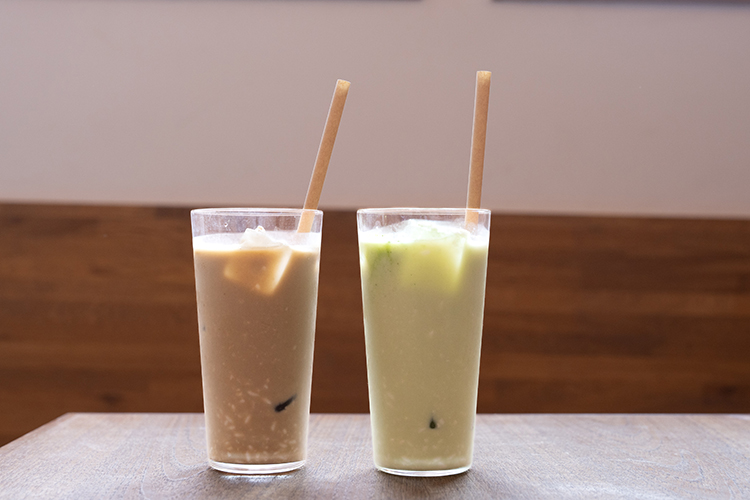
Hojicha Amazake Latte and Matcha Latte, both made with oat milk. They’re pleasantly lumpy thanks to the koji used.
The cafe is uncompromising about ingredients. Amazake is used as a sweetener in its house-made confections, and the menu features an abundance of seasonal ingredients.
“All our menu items are developed in-house. For example, the house-made an bean paste used in our flagship Amazake An Butter Sandwich is cooked in amazake. And our Japanese Granola made with seasonal fruits is sweetened with Koji Mitsu sweetener from Uonuma Jozo. This granola has such a rich flavor it’s delicious as is. It goes really well with a drink!”
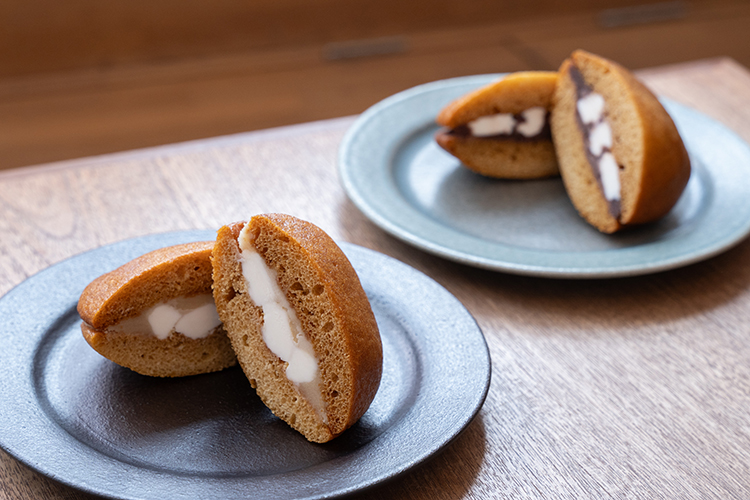
Amazake An Butter Sandwiches made with soy butter. Foreground: Fragrant Yuzu Shiro-an (white bean paste. Background: Mildly sweet Koshi-an (strained bean paste).

Japanese Granola. This eminently crunchy, satisfying snack features different dried fruits depending on the season: mandarins, peaches, pears, and so forth.

The Blossom Muffin. This filling treat too comes in many seasonal variations. Especially popular in fall and winter is the sweet potato muffin, which is mildly sweet.
How did Toshiaki become interested in fermented foods in the first place?
“When you spend time overseas on tour, you begin to miss Japanese food. Simple things like miso soup and rice with pickles. I hardly gave such foods a second thought when I was in Japan. I just took them for granted. But traveling abroad reawakened me to the attractions of time-honored Japanese fermented foods like miso and soy sauce. After that, I discovered that different parts of Japan each have their own unique fermented foods. That fascinated me. Miso, for instance, shows tremendous regional variation.”
In 2021, Toshiaki was named a Miso Ambassador by Marukome Co., Ltd. He was the first person outside the company to earn the qualification, which Marukome began granting in house in 2017 to promote awareness of miso culture.
“I’d been teaching myself about fermented foods, but I wanted to develop a more in-depth knowledge. Then I was informed that Marukome had its own in-house qualification program. This is designed not just to sell the company’s products but also to keep alive the culture of traditional Japanese miso. That’s something I could identify with. It just so happened that in 2021, my company launched a project called Team Fair Play, which seeks to deliver social solutions in the spirit of fair play in sports. Marukome and I are committed to the same vision, and I’ve been working on various initiatives with them ever since.”

Launched in 2021, Team Fair Play involves athletes teaming up with the public to create new value in order to make life fairer for everyone and everything.https://teamfairplay.jp/ (in Japanese).
Team Fair Play undertakes a wide range of activities in partnership with businesses and individuals.
“For example, we head to sports venues in our food truck and serve amazake. Stadium food offers surprisingly few healthy choices. We serve smoothies made with fruit that has been damaged during distribution and can’t be sold. ‘Benched fruit’ is what we call it. It’s failed to make the starting lineup, as it were. We also serve miso soup made with ‘benched vegetables.’ We were at the 2023 Hokkaido Marathon, and we supplied an amazake beverage made with ‘benched’ Furano melon to runners who completed the full marathon. It tasted exquisite! No place is more closely associated with health than where people engage in sports. Sure, supplements are valuable. But it’s important to consume the best natural ingredients after playing sports and keep your gut in good condition by eating fermented foods. That’s the message I want to get across.”
“When I share something I’ve thought of with our members, they all immediately go into action,” says Toshiaki. “That’s gratifying. I just come up with the ideas [laughs].”
Our visit fell during the 2023 Rugby World Cup, and Toshiaki was departing for Paris the next day. He’s a busy guy. He heads all sorts of projects at once. As such he seems to epitomize one of the rules of Team Fair play: “First give it a try!” What is his vision for the future?
“We’re growing pesticide-free rice in Miyazaki with the cooperation of a local farmer. We sell it at our cafe. I’ve got a close connection to Miyazaki. I used to attend annual training camp there when I was on the Japanese national team. This is the second season we’ve grown rice there, and it really tastes good. The place has the kind of pristine environment necessary to growing rice, which is why it tastes so good. That experience has got me thinking about issues like the environment and business succession in local communities. I hope that through food, others will similarly become aware of the various issues out there. Personally, I think it would be fun to try our hand at making our own koji malt using rice one day and producing our own amazake and miso.”
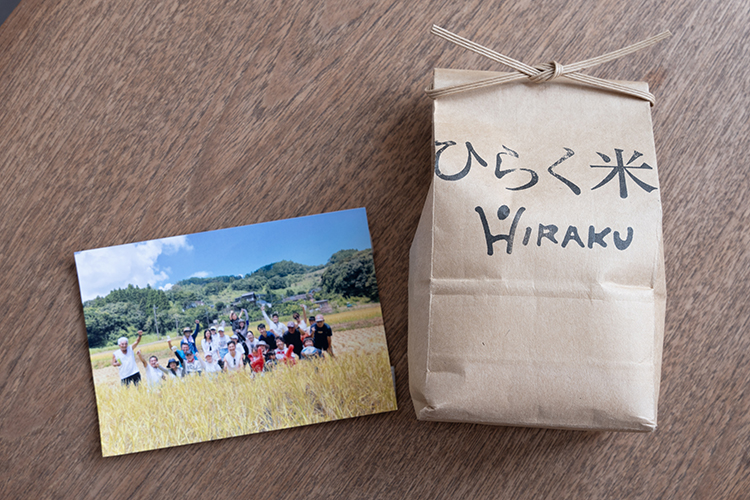
HiRAKU Rice, a variety of Koshihikari grown in Miyazaki celebrated for its excellent flavor. You can buy it at the cafe!
“What do you think this is?” says Toshiaki as he picks up a green vegetable shaped like a rugby ball.
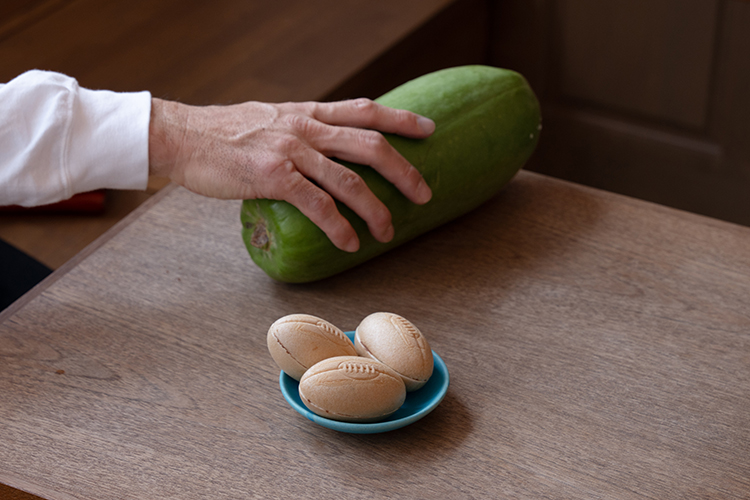
The cute-looking ball-shaped wafers in the foreground are a special available only during the World Cup. They’re called Blossom Creamy Chocolate Monaka Wafers: Classic Rugby Balls. These scrumptious treats contain a creamy chocolate filling combined with dried figs and roasted almonds. The filling is sweetened solely with amazake and Koji Mitsu sweetener, No sugar is used.
“Actually, it’s a green papaya. It was grown in Sagamihara, Kanagawa Prefecture, of all places. Kanagawa is the last place where you’d expect anyone to grow papayas, right? There are growers who are working hard trying interesting stuff like this, and one of my upcoming goals is to bring them to more people’s attention. It would be really neat to bring different people together by doing things at the cafe and selling stuff online and holding events. Another of my aims is to introduce Japanese food culture overseas. Just the other day, right before the World Cup began, I had a conversation with Thierry Dusautoir, former captain of the French national team, at the Japanese Culture House of Paris. At the party afterward, we served sorbets and smoothies made with amazake. Marukome supplied some of their Plus Koji Koji-Amazake Yuzu Blend for the event, and people said it was delicious. The citrus flavor evidently helped it go down smoothly. Overseas, Japanese food is already perceived as being good for you, but many aspects of Japanese food culture are still unfamiliar. Fermented foods are especially good for you, and I’d love to share their wonders with people around the world.”
